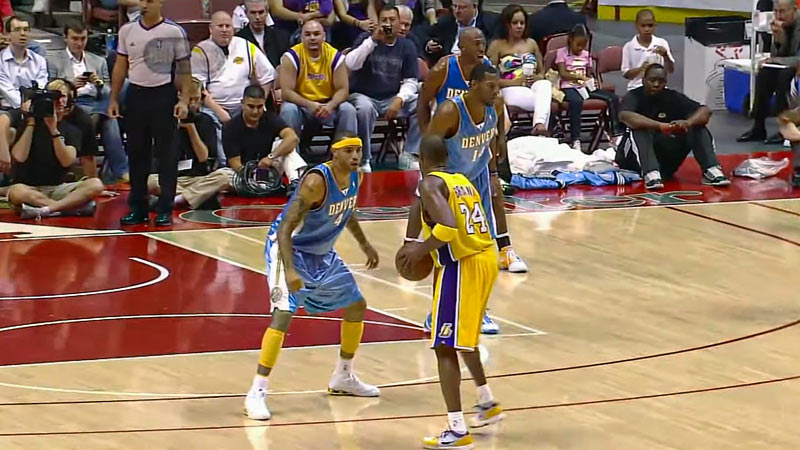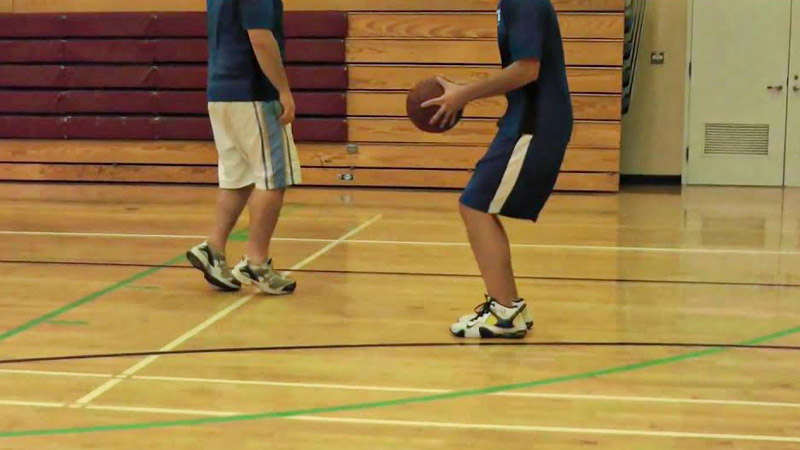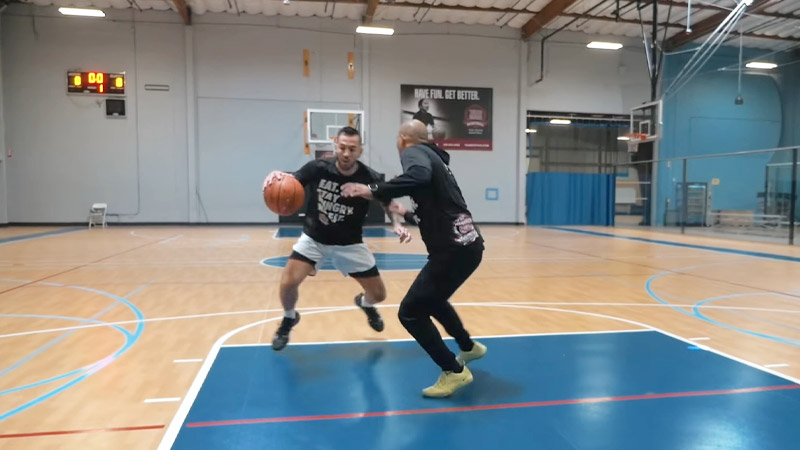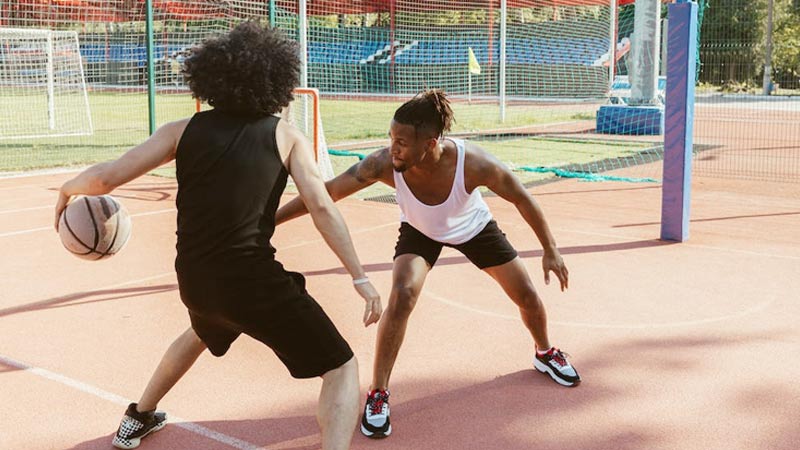Pivoting is a fundamental skill in basketball that allows players to change direction while maintaining control of the ball.
It serves as an anchor, enabling players to maneuver around defenders, create space, and make accurate passes or shots. Understanding the concept of pivoting and mastering its various techniques is crucial for players at all levels of the game.
In this article, we will explore some frequently asked questions (FAQs) about pivoting in basketball.
What is Pivoting in Basketball?
WhatPivoting in basketball refers to the technique used by a player to establish a secure foot pivot and change direction while maintaining one foot in contact with the floor.
It is a fundamental skill that allows players to evade defenders, create space, and make passes or shots.
When a player catches the ball or picks up their dribble, they are required to keep one foot planted while moving the other foot to adjust their position.
The foot that remains stationary is called the pivot foot. The pivot foot serves as an anchor, allowing the player to turn or change direction without violating the traveling rule. Is the
There are various types of pivots commonly used in basketball:
Forward Pivot (Front/Inside Pivot)
The forward pivot is performed by rotating the ball of the pivot foot while keeping the heel in contact with the floor. This pivot allows the player to face any direction and is commonly used when receiving a pass or when preparing to make a move toward the basket.
It provides a strong base and allows the player to protect the ball while surveying the court for passing or scoring options. From the forward pivot position, the player can choose to pass, shoot, or initiate a dribble in any direction.
Reverse Pivot (Back/Outside Pivot)

The reverse pivot involves pivoting on the heel of the pivot foot while keeping the ball of the foot in contact with the floor. This pivot allows the player to turn and face the opposite direction while maintaining control of the ball.
It is often used when a player catches the ball with their back to the basket or when they want to change direction away from an aggressive defender. The reverse pivot is useful for creating space and setting up scoring opportunities by facing the basket or finding open teammates for passes.
Drop Step
The drop step pivot is commonly used by most players when they receive the ball with their back to the basket. It involves taking a step back with the non-pivot foot and pivoting on the pivot foot to face the basket or make a move toward it.
The drop step allows the player to establish better positioning against defenders and can be used to create scoring opportunities near the basket. It is particularly effective for power moves, such as layups, dunks, or post-up plays.
Step Through
The step-through pivot is a versatile move used to maneuver around defenders. It is often employed when a player receives the ball while being closely guarded. To perform the step-through, the player steps through with their non-pivot foot while pivoting on the pivot foot.
This move helps create separation from the defender and opens up passing lanes or driving opportunities. The step-through can be combined with fakes and changes of direction to deceive defenders and gain an advantage on offense.
Mastering these different types of pivots is essential for basketball players at all levels. They allow players to maintain control, create scoring opportunities, and make accurate passes while adhering to the rules of the game.
Developing proper footwork, balance, and body control through practice and repetition will greatly enhance a player’s ability to utilize pivots effectively in various game situations.
What Is the Official Basketball Pivoting Rule?
The official basketball pivoting rule, as outlined by FIBA (International Basketball Federation) and most national basketball associations, states that a player who catches the ball while standing still or comes to a stop while in possession of the ball must establish a pivot foot.
The pivot foot must remain on the floor until the player has released the ball to start a dribble, passed the ball to a teammate, or attempted a shot.
Once a player has established a pivot foot, they are allowed to pivot on that foot by turning or changing direction while keeping the other foot grounded.
They can lift the pivot foot momentarily, but it must be returned to the floor before the player releases the ball for a pass or shot attempt.
Lifting the pivot foot and returning it to the floor does not constitute a traveling violation if the player maintains their dribble or passes or shoots the ball before the pivot foot is lifted again.
It’s important to note that the specific rules may vary slightly depending on the league or level of play.
For example, in the NBA (National Basketball Association), a player is allowed a “gather step” after catching the ball, which allows them to take one additional step before establishing the pivot foot.
In summary, the official rule requires a player who catches the ball while standing still or comes to a stop to establish a pivot foot.
They can pivot on that foot while keeping the other foot grounded, but they must release the ball for a pass or shot before lifting the pivot foot again to avoid a traveling violation.
Situations When Pivoting Is Very Essential

Pivoting is an essential skill in basketball and is crucial in various game situations. Here are some scenarios where pivoting is particularly important:
Post-Up Plays
In the low post area, where big players often operate, pivoting becomes vital. When a player receives the ball in the post, they typically face strong defensive pressure.
Pivoting allows the post player to protect the ball, survey the court, and assess their scoring options. By pivoting effectively, they can maneuver around defenders, create space for a shot, or make accurate passes to open teammates.
Breaking Down Defenders
Pivoting is a valuable technique for perimeter players when faced with a tight defense. When a defender is playing aggressive, on-ball defense, a player can use pivots to change direction, create separation, and get past their defender.
By executing quick and controlled pivots, the offensive player can open up driving lanes, create scoring opportunities, or find open teammates for passes.
Offensive Rebounding
Offensive rebounding is a crucial aspect of basketball, and pivoting plays a significant role in securing additional possessions. When an offensive player grabs an offensive rebound, they often find themselves surrounded by defenders. Pivoting allows them to establish a strong base, protect the ball, and assess the situation before attempting a shot or making a pass.
By pivoting effectively, the player can evade defenders, create better scoring angles, or find open teammates for easy baskets.
Avoiding Traps and Double Teams
Pivoting is a valuable skill when a player faces aggressive trapping or double-teaming defenses. When trapped by defenders, a player can use pivots to shield the ball, change direction, and create passing angles to escape the trap.
By maintaining their pivot foot and using pivoting techniques, players can effectively navigate through pressure situations, keep their dribble alive, and make accurate passes to open teammates.
Offensive Transitions
During fast breaks or offensive transitions, pivoting can help players maintain control and make quick decisions. When a player receives an outlet pass or advances the ball on a fast break, they may need to change direction or evade defenders while maintaining their dribble.
Pivoting allows players to keep their options open, scan the court, and make accurate passes or take open shots while on the move.
These are just a few examples of situations where pivoting is highly essential in basketball.
Whether it’s in the post, breaking down defenders, securing offensive rebounds, handling traps, or executing offensive transitions, mastering the art of pivoting provides players with better control, balance, and decision-making capabilities on the court.
How to Try a Pivot in Basketball?

To effectively try a pivot in basketball, follow these steps:
Establish Your Pivot Foot
Catch the ball while standing still or come to a stop while in possession of the ball. Determine which foot will be your pivot foot. Typically, it is the foot closest to the basket or the foot that feels more comfortable for you.
Plant Your Pivot Foot
Keep your pivot foot firmly planted on the floor. This foot should remain in contact with the floor until you pass, shoot, or start a dribble.
Maintain Balance and Body Control
Keep a low center of gravity, bend your knees slightly, and maintain good balance. This will help you stay stable and react quickly to any defensive pressure.
Use Your Pivot Foot to Turn or Change Direction
With your pivot foot serving as the anchor, you can pivot on the ball of your foot or on the heel, depending on the type of pivot you want to execute.
Rotate Your Body
Rotate your body smoothly and under control, using your pivot foot as the axis. Turn your shoulders, hips, and head in the desired direction, while keeping your eyes up to scan the court for passing or scoring options.
Keep the Non-pivot Foot Grounded
While pivoting, your non-pivot foot should remain in contact with the floor, allowing you to maintain your balance and pivot effectively.
Make a Decision
Once you’ve pivoted, assess the situation. Look for open teammates, scoring opportunities, or passing lanes. Decide whether to pass, shoot, or continue pivoting to create better options.
Pass, Shoot, or Start a Dribble
Once you’ve made your decision, execute the appropriate action. If you pass or shoot, ensure your pivot foot is still on the floor until the ball is released. If you start a dribble, lift your pivot foot off the floor to initiate the dribble.
Remember to practice pivoting from different positions and angles on the court to become comfortable and proficient in executing various types of pivots. Consistent practice will help develop your footwork, balance, and decision-making abilities when using pivots in game situations.
Significance of Pivot in Basketball

The pivot is a fundamental skill in basketball that holds significant significance for players. Here are some key reasons why the pivot is highly significant in the game:
Maintaining Control
Pivoting allows players to maintain control of the ball while surveying the court for passing or scoring options. By establishing a pivot foot, players can anchor themselves and protect the ball from defenders, reducing the risk of turnovers.
Creating Space
Pivoting enables players to create space and separation from defenders. By executing well-timed and quick pivots, players can change direction, evade defenders, and find open areas on the court. This extra space provides players with better scoring opportunities or passing lanes.
Evading Defenders
Pivoting is a valuable technique for maneuvering around aggressive defenders. By using pivots effectively, players can deceive defenders, change direction, and create angles to drive to the basket or find open teammates. It allows offensive players to gain an advantage by using their footwork and body control to outmaneuver defenders.
Making Accurate Passes
Pivoting is crucial for making accurate passes in basketball. It allows players to face their intended targets, properly align their bodies, and make precise passes to teammates. Pivoting enables players to see the entire court and make better decisions, leading to efficient ball movement and scoring opportunities.
Shot Creation
Pivoting plays a significant role in shot creation. By pivoting, players can position themselves for open shots by creating separation from defenders.
Pivoting allows players to face the basket, set up their shooting stance, and release the ball with proper technique. It is especially important for post players who use pivots to establish better positioning and create scoring opportunities near the basket.
Reading the Defense
Pivoting helps players read the defense and make informed decisions. By pivoting, players can observe how defenders are reacting, identify open teammates, and exploit defensive weaknesses. It provides players with better court vision, allowing them to make split-second decisions on whether to pass, shoot, or continue pivoting.
Offensive Rebounding
Pivoting is crucial for securing offensive rebounds. When players grab an offensive rebound, they often find themselves surrounded by defenders.
Pivoting allows them to establish a strong base, protect the ball, and reset the possession. It enables players to pivot away from defenders, create scoring opportunities, or find open teammates for second-chance points.
Mastering the art of pivoting is vital for players in all positions. It enhances a player’s overall control, footwork, balance, and decision-making abilities.
Pivoting empowers players to effectively navigate through pressure situations, create opportunities, and contribute to their team’s offensive success.
FAQs
What exactly is pivoting in basketball?
Pivoting in basketball refers to the technique of establishing a secure foot pivot while maintaining one foot in contact with the floor. It enables players to change direction and make offensive moves without committing a traveling violation.
Why is pivoting important in basketball?
Pivoting is essential in basketball as it allows players to maintain control, create space, and evade defenders. It provides better court vision, enables accurate passing, and aids in shot creation. Pivoting also helps players read the defense and make informed decisions, contributing to overall offensive success.
What are the different types of pivots in basketball?
There are several types of pivots in basketball, including the forward pivot (inside pivot), reverse pivot (outside pivot), drop step, and step through. Each type of pivot serves a specific purpose and can be used in different game situations.
Are there any rules or restrictions when pivoting in basketball?
Yes, there are rules to abide by when pivoting in basketball. Once a player catches the ball while standing still or comes to a stop, they must establish a pivot foot. The pivot foot must remain on the floor until the player releases the ball to pass, shoot, or start a dribble.
Lifting the pivot foot and returning it to the floor without violating the traveling rule is also allowed.
How can I improve my piloting skills?
Improving pivoting skills requires practice and focus on footwork, balance, and body control. It is important to work on different types of pivots from various positions on the court.
Practicing with game-like scenarios, such as facing defensive pressure or making quick decisions, can also enhance pivoting proficiency.
End Call
Pivoting is a fundamental skill that holds great significance in basketball. It allows players to maintain control, create space, evade defenders, make accurate passes, and create scoring opportunities.
By understanding the concept of pivoting and developing the necessary footwork and body control, players can enhance their overall performance on the court.
Regular practice and application of different types of pivots will enable players to master this essential skill and contribute to their team’s success.







